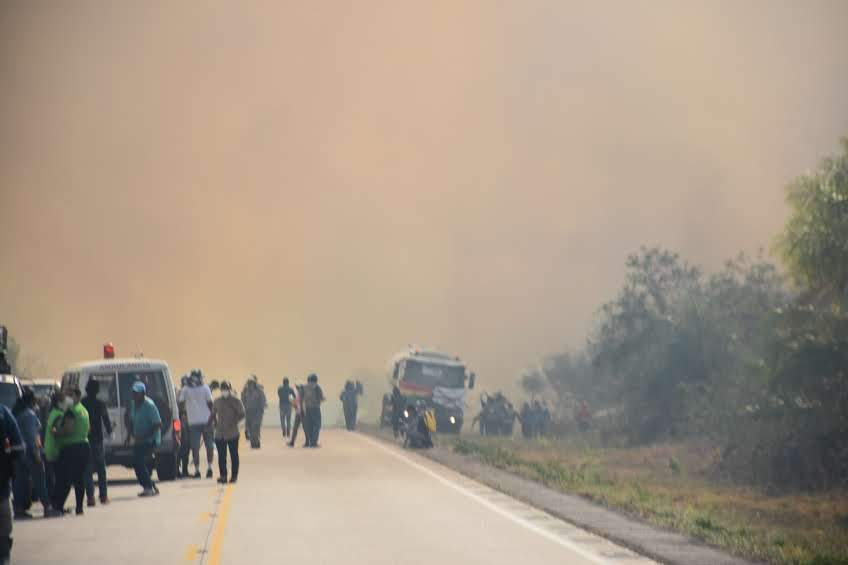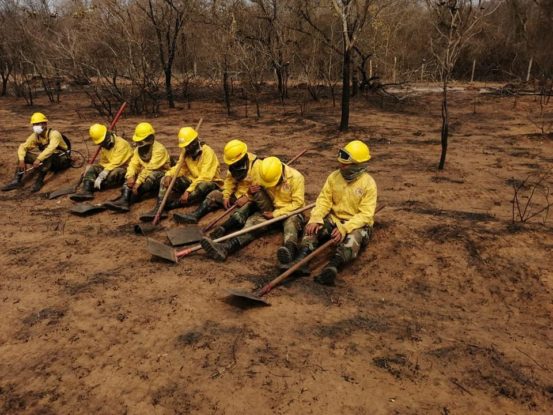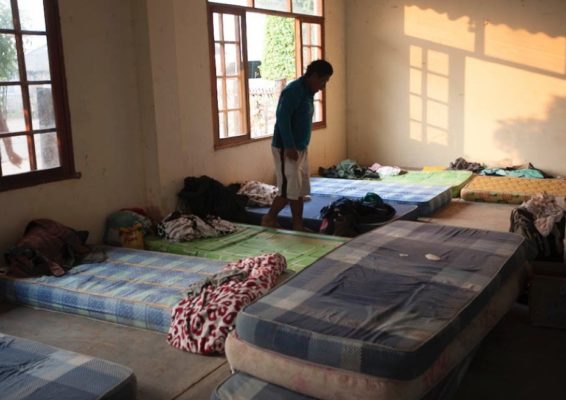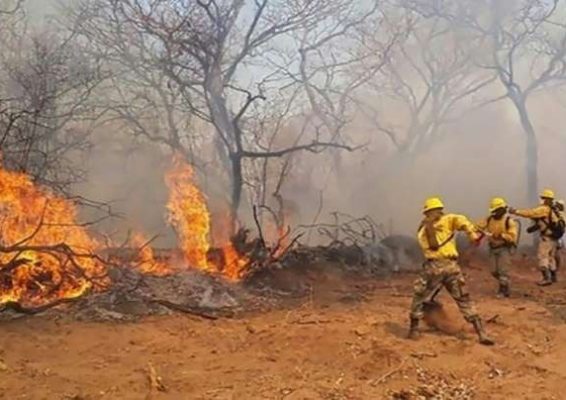When firefighter Daniela Azero and her team first saw the extent of the uncontrolled forest fires in eastern Bolivia near the Amazonian border with Brazil, it made a big impression. “There were just so many hotspots – huge columns of smoke and big, powerful flames,” she says.
The Chiquitano dry forest where Bolivia’s blazes are concentrated has never burned like this before, and the disaster has taken the country by surprise. “Unfortunately, it’s because people have been deforesting and burning in order to open up land for agriculture.”
Azero’s team had been summoned from the Bolivian capital La Paz, joining other firefighters from around the country and Peru. They got to work trying to extinguish some of the fires, as well as clearing scrub and digging trenches to stop the fires from spreading further. “It’s really hard, physical work,” says Azero, who was one of only four women in her team of 70.
Lodgings were basic, and after long, hot days of work, the firefighters slept in mattresses on the floor in lodgings in the local communities, which have been supporting as they can.
“They’ve helped us access areas which are difficult to get to and provided us with materials and access to water,” says Azero. “But they are very sad, too, about what is happening here,” she says.
Like the fires happening in Brazil and elsewhere in the world, the new magnitude of Bolivia’s blazes is largely due to burning on newly deforested land, spurred by a decree President Evo Morales issued in July that increased the area farmers are permitted to burn from five hectares to 20.
While controlled burning for agriculture is a common practice that has been carried out for thousands of years in many parts of the Amazon, it’s being used in the Chiquitano dry forest by many new residents and private companies “who don’t know the environment they’re working in,” says Rubens Barbery, director of the Center for Participation and Sustainable Human Development (CEPAD), a Bolivian NGO.
“As its name suggests, this forest is very dry, and it’s not practical to use fire to clear land in this situation,” says Barbery. “It’s practical for the individual who does it – it makes it easier to clear the land – but it’s not appropriate for the forest ecosystems here and for these conditions. One uncontrolled flame can escape when people aren’t watching and create this kind of disaster.”
In the last few days, there has been rain in the worst-hit areas, which has repressed some of the fires but hasn’t been sufficient to extinguish them completely, says Azero. “One of the characteristics of the Chiquitano dry forest is that it has a cap of vegetation on top,” explains Barbery. “So that holds heat in the part underneath, even if it has stopped burning up above.”
A major concern for the firefighters now is the fires’ proximity to the Noel Kempff Mercado National Park. With more than 4,000 plant and 130 animal species living in its 1.6 million hectares, it’s one of the largest and most biodiverse parks in the Amazon Basin.

Haze from the fires engulfs eastern regions of Bolivia. Romaneth Hidalgo
But the drought conditions currently affecting the park and drying its vegetation, as well as the park’s challenging accessibility means that flames should be kept outside its borders at all costs. “It would be almost impossible to control the fire if it reached there,” says Barbery. “So the majority of the firefighters’ efforts at the moment are in making sure that the fire doesn’t get into the park.”
The situation is still very changeable and unpredictable, he says, and the fires are presently far from under control. “We’re hoping that this week we’ll have good news. We’re all crossing our fingers that the rain will solve that which humans cannot.”
Looking forward, both Barbery and Azero emphasize the importance of preventative measures. “It’s unfortunate that it’s only when we have these big disasters that we go in and plan,” says Azero.
“We are already 20-something days deep in a fire that we knew how to control from the beginning,” laments Barbery. “If the national authorities and departments had given it the importance it required, we wouldn’t be in a mess of this magnitude. So I think we need consciousness to improve in every sense, and we need to be able to count on an early warning system that allows us to quash fire quickly and not let it spread so far.”

Digging trenches is one of the methods used by the firefighters to keep flames from spreading. Courtesy of CEPAD
Digging trenches is one of the methods used by the firefighters to keep flames from spreading. Courtesy of CEPADBolivia is now working on developing early-response teams in closer proximity to fire-prone areas as well as an early-warning alert system. International contributions to the cause are welcome, adds Barbery, because prevention programs are often more expensive and challenging to implement than the fire control work itself. In the immediate, as village water supplies are being channeled toward the fires, foreign aid is also needed to bring in supplementary water for drinking.
Azero and Barbery also hope the disaster will help instill better environmental awareness in the population as whole. “I think it behoves each one of us to be conscious about how we are taking care of the environment,” says Azero. “Sadly, the environment is often the last thing on people’s minds. They don’t take it into account very much; they don’t know the value that it has.”
We want you to share Forests News content, which is licensed under Creative Commons Attribution-NonCommercial-ShareAlike 4.0 International (CC BY-NC-SA 4.0). This means you are free to redistribute our material for non-commercial purposes. All we ask is that you give Forests News appropriate credit and link to the original Forests News content, indicate if changes were made, and distribute your contributions under the same Creative Commons license. You must notify Forests News if you repost, reprint or reuse our materials by contacting forestsnews@cifor-icraf.org.

